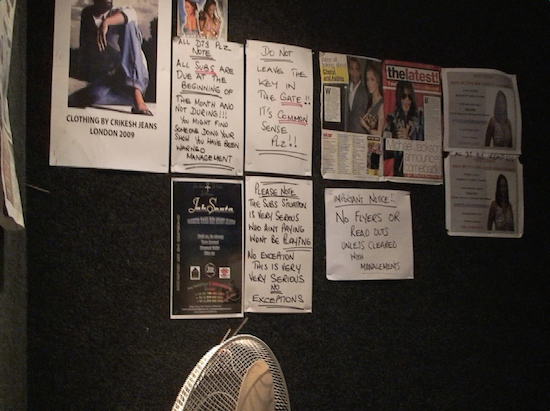Joy White
Over the last two decades, I have amassed and collated flyers, promotional material, film, photographs, interviews and merchandise that relate to the story of the grime music scene in London, the UK and beyond. In 2007, I began interviewing young people who were involved in grime in some way: MCs, DJs, producers, event promoters, and videographers, among others. Probably the most unusual item in my collection is the flyer for a London barber who had relocated to Ayia Napa in Cyprus for the summer of 2009.
Grime music originated in east London at the turn of the 21st century. We can trace the genealogy of grime back to the Jamaican sound systems and their UK counterparts, filtered through hip hop, reggae, dancehall, jungle and UK garage. It is a sonic representation of its origins: the council estates and street corners of inner-city east London.
Within the urban spaces of the east London streetscape, it is possible to see the residual marks of many previous communities. From the French Huguenots who came to Spitalfields in the 17th century to the 1920s Coloured Men’s Institute in Canning Town, the east London boroughs of Tower Hamlets and Newham have been sites of continuing movement and migration. Postwar communities from the Commonwealth, the Windrush generation, have also left a significant mark on the social, economic and cultural landscape of the UK.
Despite recent gentrification, these areas still contain multicultural communities who draw on diverse cultural legacies. Grime is a musical form that comes out of the convivial endeavours of young people of Caribbean, African and English heritage. It is now an internationally recognised musical genre. With a foothold in Europe, and in North America, it has been suggested that it is the most exciting musical genre to have emerged from the UK since punk in the 1970s.
As a 21st-century Black British musical form, grime draws from an eclectic mix of sounds structured around 140 beats per minute. Grime beats disturb and disrupt, forming a sonic representation of the alien spaces that its creators occupy – listen to Danny Weed’s classic instrumental <a href="https://www.youtube.com/watch?v=Ok4UHXhA9Gc" target=out">’Creeper’ as an early example. In contrast to UK rap, for example, grime lyrics are delivered at a rapid-fire pace. Grime’s sonic landscape anchors it in its origins in inner-city east London. The early days of the grime scene housed the creative outpourings of young people who refused to conform to the highly polished, aspirational aesthetic of the UK garage scene.
Pirate radio stations such as Rinse FM, Deja Vu and Freeze had a central role in showcasing and sharing grime. While in the early days, the vibe, energy and content of those stations were admired and emulated by licensed radio, at the same time the Metropolitan Police and Ofcom saw pirate radio simply as a criminal nuisance that jeopardised and disrupted the emergency services. An Asbo issued in 2003 banned DJ Slimzee from Rinse FM, AKA Dean Fullman, from entering any building over four storeys high without permission. Other control measures included Form 696, introduced by the Metropolitan Police in 2005 and abolished in 2017. This event risk-assessment form, supposedly intended to reduce serious crime, asked event promoters to provide the name, date of birth and contact details of every artist performing at an event.
What sets grime apart is its DIY nature. Talent alone can get you started, and perhaps for the first time, it was possible to sustain a musical career without the input of an intermediary such as a record company. For Black youth in particular, the grime scene is a site of emancipatory disruption where it is possible to step into new identities as artists, performers, or entrepreneurs. In a socio-economic landscape that is beset by racism and inequality, this emancipatory aspect cannot be ignored.

Inside a pirate radio station, 2009
As with any real-life tale, there is no single story of grime. It is layered, nuanced and complex. The moment where one genre ends and another begins is not clear-cut; the edges are blurred. As memories fade, or play tricks, conversations continue about what was the first grime track, or where t…



